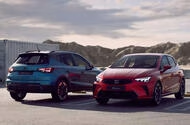What’s Changing for the Seat Ibiza and Arona in 2026?
If you’ve been following the twists and turns of the automotive world, you might have noticed Seat’s two smallest models—the Ibiza and Arona—have been flying under the radar lately. That’s about to change. After years of speculation and a lot of focus on its upmarket sibling Cupra, Seat is gearing up for a major update to both the Ibiza and Arona, slated for early 2026.
So, what’s actually changing? According to Markus Haupt, Seat’s interim boss, the company is doubling down on its commitment to these models. While the facelift won’t be radical—preview images hint at subtle tweaks rather than a complete overhaul—the real story is what’s happening under the hood and behind the scenes.
Why Is Seat Investing in Petrol Cars While Cupra Goes Electric?
It’s a fair question. With Cupra making bold moves into the electric and plug-in hybrid space, why is Seat sticking with petrol engines for its entry-level cars? The answer comes down to market demand and regulatory flexibility.
Haupt put it simply at the Munich Motor Show: Seat and Cupra serve different customers in different markets. While Cupra is pushing the boundaries with electrification, Seat is carving out a niche as a specialist in smaller, more affordable cars—especially in regions where electric vehicle (EV) adoption is still lagging.
This isn’t just a strategic hunch. Data from the European Automobile Manufacturers Association (ACEA) shows that, even in 2024, nearly 90% of new car sales in many European countries were still internal combustion engine (ICE) or hybrid vehicles. For a lot of buyers, especially those shopping for their first car or a practical city runabout, petrol and mild-hybrid options remain the go-to.
How Will the Ibiza and Arona Meet Stricter Emissions Rules?
The elephant in the room is the looming EU7 emissions regulations, which are set to tighten the screws on automakers across Europe. Seat isn’t ignoring this. The updated Ibiza and Arona will introduce mild-hybrid petrol engines, following the lead of their cousin, the Volkswagen Polo.
This is a big deal for a couple of reasons. First, it means Seat is investing in cleaner, more efficient technology without pricing out its core customers. Second, it’s a clear signal that affordable cars can still have a future in a world of tougher emissions standards.
It’s not just about compliance, either. The mild-hybrid tech should deliver real-world benefits—think better fuel economy, lower running costs, and a smoother driving experience. For many drivers, especially those not ready or able to make the leap to full electric, this is a welcome middle ground.
What Does This Mean for the Rest of the Seat Lineup?
With all this focus on the Ibiza and Arona, you might be wondering what’s next for Seat’s larger models like the Leon and Ateca. Here’s where things get interesting. Both of these cars are also sold as Cupra models, and there’s speculation that, as Seat doubles down on its role as a small car specialist, the Seat-branded versions of the Leon and Ateca could eventually be phased out.
Wayne Griffiths, Seat’s former boss, hinted that the Cupra Leon and Formentor will continue in their current forms—petrol and plug-in hybrid—for years to come, but the next generation will be fully electric. This shift is part of a broader trend across the industry, as brands look to differentiate themselves and avoid overlap.
Is Seat Turning Its Back on Electric Cars?
Not at all. In fact, the strategy is more nuanced than it might seem at first glance. Griffiths was clear: Seat isn’t abandoning electrification. Instead, the brand is responding to real-world demand. While Cupra leads the charge into the electric future, Seat is making sure it doesn’t leave behind the 90% of buyers who still want efficient petrol, hybrid, or plug-in hybrid options.
This flexibility is key. As Griffiths put it, “We can’t force consumers to drive electric cars.” The goal is to offer both ICE and EV options, meeting customers where they are while still moving toward a zero-emissions future.
How Will Affordable Electric Cars Change the Game?
One of the most exciting developments on the horizon is the arrival of the Cupra Raval, a sub-€25,000 electric supermini. This car, along with similar models from Volkswagen and Skoda, could finally make electric mobility accessible to a much wider audience.
The impact? If these affordable EVs deliver on their promise, we could see a real tipping point in urban areas, where small, efficient cars are in high demand. But until that happens, Seat’s strategy of offering both combustion and electric options looks like a smart way to keep all bases covered.
What’s the Big Takeaway for Buyers?
If you’re in the market for a practical, affordable small car, the upcoming Seat Ibiza and Arona updates are worth watching. They represent a thoughtful response to changing regulations and shifting consumer preferences—without losing sight of what makes these models popular in the first place.
For now, Seat is betting that there’s still a strong appetite for petrol and hybrid cars, especially in the entry-level segments. At the same time, the brand is keeping one eye firmly on the electric future, ready to pivot as the market evolves.
The bottom line? Whether you’re a die-hard petrol fan or an EV enthusiast, there’s never been a more interesting time to be a small car buyer. And with Seat and Cupra charting distinct but complementary paths, you’ve got more choice than ever.

